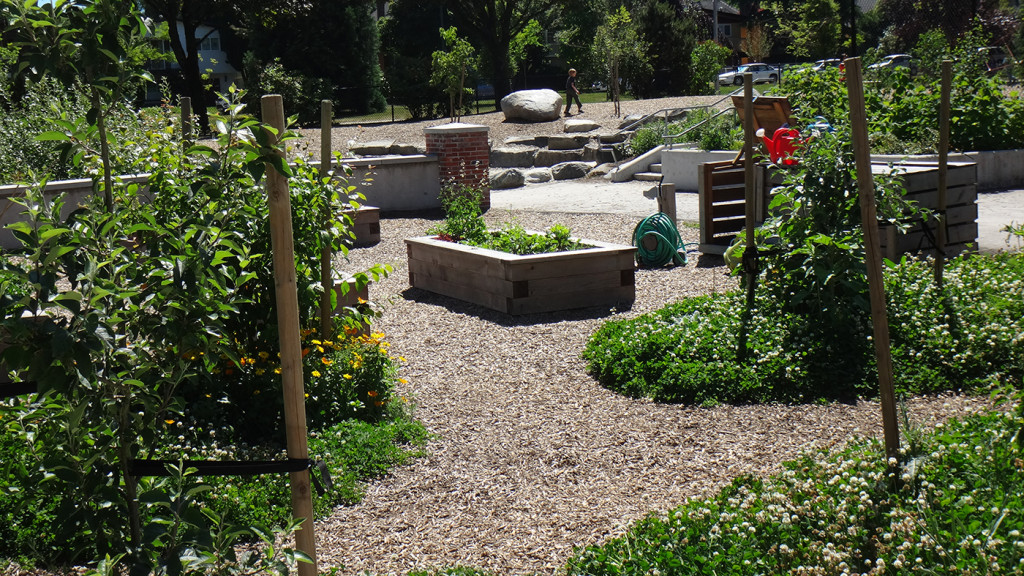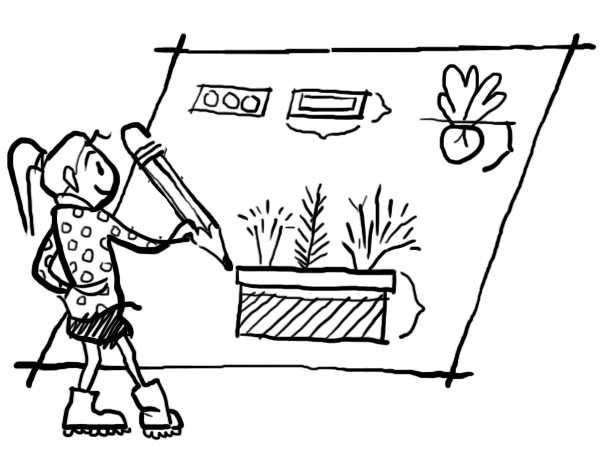Guiding Principals
School gardens may be integrated with other elements such as outdoor classrooms, but they merit a separate discussion. In 2010, the Vancouver School Board passed a Garden Policy, outlining the important role that school gardens can play in students’ learning. According to the VSB, “Garden-based learning can enhance academic achievement through integration of hands-on experiences into diverse subjects such as math, science, nutrition, and environmental education” (VBE School Food Garden Policy Statement). A school garden encourages students to think about healthy eating and to make healthy food choices for themselves.
Beyond learning, school gardens can allow for the incorporation of fresh and healthy local fruit and vegetables into the cafeteria and existing school meal programs. Further, the benefits of school gardens extend well beyond the school site itself, providing community green space and the possibility for collaborative community gardens. These gardens are an excellent way to build connections with the surrounding community.

Food and community garden at Lord Kitchener Elementary School, Vancouver (Image: Jonathan Losee Ltd. Landscape Architecture)
The guiding principles for the Vancouver Board of Education (VBE) School Garden Policy are as follows:
- To embrace the spirit of caring, social responsibility, inclusiveness, co-operation, team-work, consensus, and collaborative processes in the development of the garden space
- To ensure the involvement of children (daycare) and students (schools) throughout the planning, design, construction, and maintenance of the garden space
- To give students the opportunity to plant, harvest, prepare, and eat food they have grown
- To integrate eating experiences, food gardens, food preparation, and nutritional education into the school
- To encourage the use of environmental ‘best practices’ for organic gardening (pesticide and herbicide free, no treated lumber), water use, soil building, harvesting, and seed saving
- To support students in the growing of culturally appropriate foods at their schools as well as to explore the cultural food and agriculture traditions represented by the diverse populations of Vancouver
- To promote environmental stewardship by involving students and local community in the ongoing maintenance of the garden space, weeding, watering, and garbage removal/compost care
- To respect the rights and responsibilities of the VBE grounds crews as laid out by their collective bargaining agreements
- To ensure approvals and implementation take place within a reasonable timeframe
- To ensure that no poisonous plants shall be used in the school garden, and to encourage the use of heirloom fruit and vegetable varieties where possible
- To ensure that the garden project is sustainable through ongoing maintenance throughout the school year, and maintenance that is continued through subsequent years
For more information on the school garden process, please review the entire policy here. If you aren’t based in Vancouver, we encourage you to adapt this process to your local conditions.
Design Considerations
The above principals should be embedded into any school garden design. Beyond this, there are numerous other design considerations. Firstly, the school garden needs to be located on the school ground – ideally in a location where community members can easily access the space. The scale of the school garden will also help to determine the best location, as well as any existing microclimates.
The VBE Guidelines state that a well located project will be:
- Near the school building
- Close to a water supply for plant watering as well as hand washing
- With access to parking or a driveway for delivery
- Visible to the surrounding community
- In a location that receives ample sunlight, at least 6 hours per day
- Manageable in size
- Away from dumpsters and garbage bins
- Not abutting a green space due to rodent concerns
Generally, a combination of raised bed planters and fruit trees works well, with the fruit trees strategically placed to provide shade to certain crops. Depending on how the school garden will be used for teaching and learning, it may also be a good idea to incorporate some mobile planters. Tool storage is another important consideration, and there are a number of ways that secure tool storage can be achieved, including repurposing items such as shipping containers.
